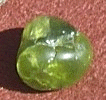 Olivene (Chrysolite) and Peridot
Olivene (Chrysolite) and Peridot
 Olivene (Chrysolite) and Peridot
Olivene (Chrysolite) and Peridot
Derivation: From "peridot" (French)
From "oliva" (Latin) olive
Description: Olivene is speckled green. If clear translucent green, then it is peridot.
Another name for olivine is chrysolite.
Peridot was used in antiquity, mined from the Red Sea island of St John. However, it was later forgotten, until Napoleon brought it back from Egyptian Treasures. Peridot was widely used in Victorian jewelry, but the stones always came from existing jewelry, as mining on St. John didn't start up again until 1930.
Rocks containing olivene are sometimes found in lava. This is thought to be pieces of the mantle of the earth, carried upwards by a volcano. Practically everything we see of the earth is from the crust of the earth, which is very thin, only 7-35 km (relatively thinner than the skin of an apple!). Underneath the earth's crust is the mantle. A piece of olivene is the closest we will get to seeing it. I find it very interesting that the basic rock of which the earth is made is green, since we tend to think of the earth as green (because of plants) although it looks blue from space.
The silicates are the most common stones sold in rock shops. They are also used as semi-precious stones in jewelry. This is not surprising, since they are beautifully colored and patterned. Quartz has magnificent crystals. It is a hard stone, so it doesn't crumble or break easily.
Silicates that can form crystals are called quartz, although some have other names as well. Purple quartz is amethyst. The silicates that can't form crystals are chalcedony and agate. Chalcedony does not have stripes and agate does, although there are many different names for the different colors and patterns.
